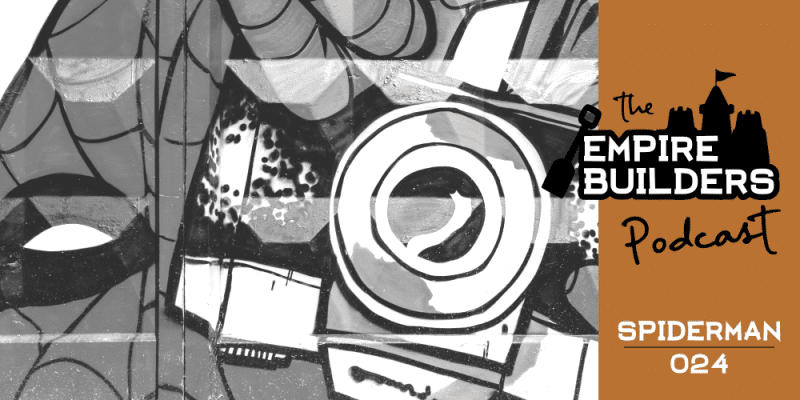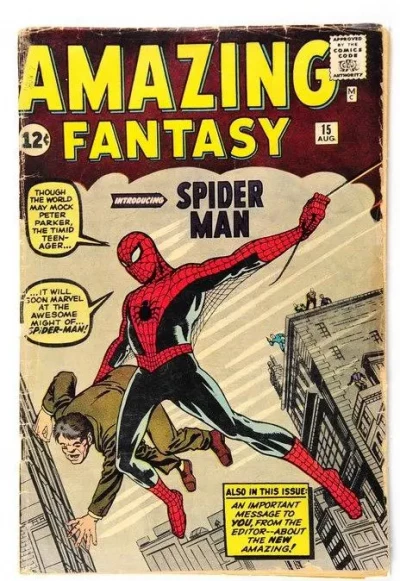
Subscribe: Apple Podcasts | Google Podcasts | Amazon Music | Blubrry | RSS | More
The birth of Spider-Man. When Stan Lee was asked to create a new super hero he needed to get creative to avoid the cutting room floor. A new kind of hero and a tricky way to get his idea past the editor.
Dave Young:
Spider-Man, Spider-Man. I don’t know the words, Steve.
Stephen Semple:
My neighborhood Spider-Man, can he swing all on a string? Right?
Dave Young:
I didn’t know that. For some reason, I know the words to 2,000 pop songs that I never intended to remember, but I don’t remember that one. I just remember da, da, da, Spider-Man. So, all right, how are you going to relate Spider-Man to a business lesson?
Stephen Semple:
There’s a great business lesson in Spider-Man. We got to go back to the start of Spider-Man. So we have to go back to early 1962. And Stan Lee is the editor at Marvel Comics in New York City. And at this time, Marvel is owned by Martin Goodman and his company is Goodman Publications. Goodman Publications owns Marvel, Stan Lee is working there as an editor. And at this point, Marvel is way smaller than DC. DC Comics is the monster and Marvel is this little tiny comic book manufacturer at that point. And Stan Lee just got off of working with Jack Kirby and Jack Kirby, for anybody who’s into comics, Jack Kirby’s one of the amazing illustrators in comic books. And they had just come off this big success creating the Fantastic Four. The Fantastic Four was a brand new idea inside comics and was really innovative and they just had this big success.
Stan Lee had an idea for a new superhero and the idea was Spider-Man. But what was going to make it unusual is, at the time all superheroes were big and strong and muscular and all this other stuff, and what he was going to do was make Spider-Man a teenager, including all the usual teenager, pimply face, angst, scared of girls problems. And there were-
Dave Young:
98 pound weakling, normal guy.
Stephen Semple:
Yeah. He was going to make him a real teenager with all the teenager angst and all the teenager problems, and there were no teenager superheroes at the time, none. They were all these big, muscular, adults. And so he took it to the publisher, Martin Goodman, and here’s what Martin Goodman had to say to him, “Worst idea I’ve ever heard. First of all, people hate spiders. So you can’t aunt call a superhero Spider-Man. Second, teenagers can only be sidekicks and you want them to have personal problems?” According to Stan Lee, this is what Martin Goodman said to Stan Lee, “Stan, don’t you know what a superhero is? They don’t have personal problems.”
Dave Young:
Oh man, what a wet mop that guy was.
Stephen Semple:
But Lee couldn’t get the idea out of his mind, so he decided to get Kirby to draw it. So he laid out the idea to Kirby and he asked him to draw it. And then when Kirby brought it to him, what Kirby drew was basically what looked like a young Superman and Stan Lee was like, “No. I want a scrawny, pimple-faced teenager.” He wanted the person to look like a teenager, like how he felt when he was growing up, all the anxieties in the feeling of being an outsider and what Kirby drew was something that looked like all the other superheroes. Basically, even Kirby resisted Stan Lee, and he said, “Stan, that’s not a superhero. That’s how you draw a sidekick, not a superhero.”
But Stan Lee still really believed it could work. But the other problem is Kirby said, “Look, I don’t want to draw this because I know it’s not going to go anywhere. The boss doesn’t like it. I don’t want to spend all my time on something that’s not going anywhere. Why don’t you give it to Steve Ditko? He’s one of the new drawers and he’s really good. Ditko is great.” So Lee takes it to Ditko and Ditko does some drawings. And Lee really believed that this was going to be bigger than Superman and bigger than Batman, but how was he going to get it out there into the world? And this, David, is where the Spider-Man lesson lives.
Dave Young:
Okay.
Stephen Semple:
 Because at the time they were about to kill a comic series called Amazing Fantasy. They were literally sending the last issue to the press to be made. And when you’re sending the last issue, no one really cares what you’re putting into it, because it’s the last damn issue. He decided to put Spider-Man into Amazing Fantasy and you can see a cover in our show notes of the Spider-Man cover, which is an Amazing Fantasy cover basically saying, “Introducing Spider-Man.”
Because at the time they were about to kill a comic series called Amazing Fantasy. They were literally sending the last issue to the press to be made. And when you’re sending the last issue, no one really cares what you’re putting into it, because it’s the last damn issue. He decided to put Spider-Man into Amazing Fantasy and you can see a cover in our show notes of the Spider-Man cover, which is an Amazing Fantasy cover basically saying, “Introducing Spider-Man.”
And here’s what happened. So it was Amazing Fantasy number 15, it was released in the summer in 1962. This was a comic they were ending and it became the highest selling comic in the Marvel line.
Dave Young:
Wow.
Stephen Semple:
And we’ve got a link in the show notes to YouTube at theempirebuilderspodcast.com. You can go to the podcast and go to Spider-Man and you can actually listen to Stan Lee say this when the sales figures came in, here’s how Stan Lee described it. Martin Goodman comes running into Stan’s office and he says, “Stan, Stan, do you remember that character we both love so much? Spider-Man? Let’s do him as a series.” And Stan swears this is true. Stan Lee swears this is exactly how Martin Goodman put it to him. And it goes on to become the number one superhero in the roster. In March of 1963, it becomes a solo series. Spider-Man goes on to become a cultural icon. In 1965, Esquire poll of college campuses found they ranked Spider-Man and fellow Marvel hero Hulk as popular as Bob Dylan as their favorite revolution area icon.
Dave Young:
I love that. I love it.
Stephen Semple:
Yeah.
Dave Young:
You know the thing that those superheroes have that the others didn’t like Superman and Batman, you want to be Batman, well, all you have to be is the orphan of a billionaire. You want to be Superman, be born on a different planet. You want to be Spider-Man, get bit by a spider in a lab. You can be anybody. Get bit by a spider. You want to be Hulk, have some weird science thing happen to you and now of a sudden you’re Hulk. And I just don’t know Hulk’s origin story, so the Marvel people are going to beat me up for this.
Stephen Semple:
Social media is going to lash back.
Dave Young:
The Marvel fans. Yeah.
Stephen Semple:
Yeah. But the connection with Spiderman is, he was the first one that was real. He had money problems. He had girlfriend problems. He felt like an outsider and this is why we connected with him. But where Stan Lee’s brilliance was in all of this was he found a great way in which to introduce Spider-Man to the world. Instead of saying no to it, he found an experiment. He put it in this comic that was ending anyway, so it was very low risk. This is not much different than even the origin of The Wizard of Ads, when Roy decided to start The Wizard of Ads, what did he do? He found the first partner was fricking Australia. If it didn’t work in Australia and it blew up, no one would ever hear about it. And then the second partner was Canada. Let’s try out Canada. Okay, Canada worked, then it’s, “All right. I’m going to do this in my backyard.”
Dave Young:
It’s more. Let’s get some more people. Yeah. It was a great lesson. And to come up with an idea and to stick with it enough. I think a lot of us give up on our ideas a little too soon, right? We hear somebody like Goodman bash it a little bit and say, “Well, that can’t be. That’s not right,” and we just go, “oh, well, I guess I must be wrong.” And I think you need to stick with it just a little longer sometimes.
Stephen Semple:
Finding an experiment also lets people be more comfortable with the risks.
Dave Young:
Yeah. So you attach your idea to an experiment, move it forward that way, and when the experiment works, you can take it mainstream.
Stephen Semple:
Yes. Absolutely. So the brilliance in Stan Lee was a couple of things, he didn’t give up on the idea and then he found a place where he could run it as an experiment and then it turns out the experiment blew the doors off and Spider-Man ended up becoming one of the most valuable products inside the Marvel universe.
Dave Young:
Thanks for listening to the podcast. Please share us. Subscribe on your favorite podcast app and leave us a big fat, juicy five star rating and review at Apple Podcast. And if you’d like to schedule your own 90 minute Empire Building session, you can do it at empirebuildingprogram.com.
- Tapping Into the Zeitgeist: Monopoly’s Origin Story - December 17, 2025
- From Mars Men Mediocrity to Sour Patch Success - December 10, 2025
- The Hidden Psychology Behind Cabela’s Success - November 28, 2025
